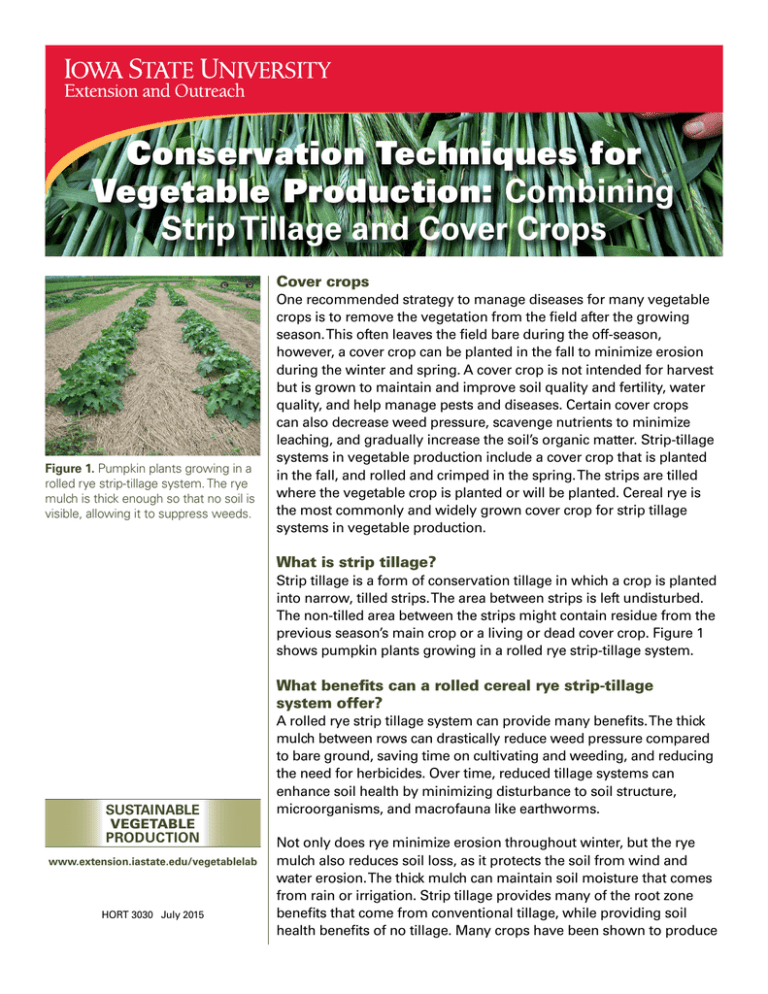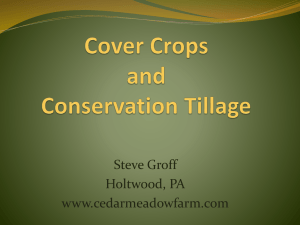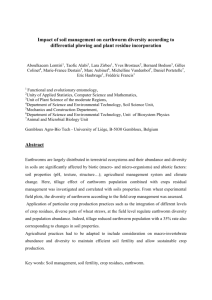Conservation Techniques for Combining Strip Tillage and Cover Crops Cover crops
advertisement

Conservation Techniques for Vegetable Production: Combining Strip Tillage and Cover Crops Cover crops Figure 1. Pumpkin plants growing in a rolled rye strip-tillage system. The rye mulch is thick enough so that no soil is visible, allowing it to suppress weeds. One recommended strategy to manage diseases for many vegetable crops is to remove the vegetation from the field after the growing season. This often leaves the field bare during the off-season, however, a cover crop can be planted in the fall to minimize erosion during the winter and spring. A cover crop is not intended for harvest but is grown to maintain and improve soil quality and fertility, water quality, and help manage pests and diseases. Certain cover crops can also decrease weed pressure, scavenge nutrients to minimize leaching, and gradually increase the soil’s organic matter. Strip-tillage systems in vegetable production include a cover crop that is planted in the fall, and rolled and crimped in the spring. The strips are tilled where the vegetable crop is planted or will be planted. Cereal rye is the most commonly and widely grown cover crop for strip tillage systems in vegetable production. What is strip tillage? Strip tillage is a form of conservation tillage in which a crop is planted into narrow, tilled strips. The area between strips is left undisturbed. The non-tilled area between the strips might contain residue from the previous season’s main crop or a living or dead cover crop. Figure 1 shows pumpkin plants growing in a rolled rye strip-tillage system. What benefits can a rolled cereal rye strip-tillage system offer? SUSTAINABLE VEGETABLE PRODUCTION www.extension.iastate.edu/vegetablelab HORT 3030 July 2015 A rolled rye strip tillage system can provide many benefits. The thick mulch between rows can drastically reduce weed pressure compared to bare ground, saving time on cultivating and weeding, and reducing the need for herbicides. Over time, reduced tillage systems can enhance soil health by minimizing disturbance to soil structure, microorganisms, and macrofauna like earthworms. Not only does rye minimize erosion throughout winter, but the rye mulch also reduces soil loss, as it protects the soil from wind and water erosion. The thick mulch can maintain soil moisture that comes from rain or irrigation. Strip tillage provides many of the root zone benefits that come from conventional tillage, while providing soil health benefits of no tillage. Many crops have been shown to produce the same yield in rolled cover crop strip-tillage systems compared to conventional tillage systems. However, while yields are often similar, cooler soils associated with strip tillage may increase the time for a crop to mature when compared to conventional tillage. In order to encourage adequate growth before killing, cover crop mixes containing peas should be seeded early in the fall season. Legume crops can be successfully grown with a cereal crop to reduce the nitrogen delay that can occur with 100% grain stands while still providing thick, long lasting mulch. Rolled cover crop system – Rolling and crimping takes place in the spring and is necessary to terminate the cover crop before planting a cash crop. The cover crop rolling or crimping can be done with a roller crimper which is typically a 10- to 15-foot long, 2-foot diameter steel cylinder hollow drum pulled by a tractor. Rolling and breaking of the shoots, is needed to terminate the cover crop. Why cereal rye? In the Midwest, a winter variety of cereal rye is a great choice for a rolled cover crop system. Cereal rye is winter hardy in Iowa, so it can be planted in the fall to provide ground cover throughout the winter and early spring. Rye can be planted late in the fall and still germinate and grow (as it requires only 34°F soil temperature for germination). When using it in a rolled rye system, early fall planting is better to ensure a thick cover crop stand. Planting in September allows the rye to become well-established before frost, leading to a more vigorous cover crop stand in the spring. Cereal rye is a popular cover crop because the seed is widely available in Iowa and it is one of the least expensive to purchase. However, other types of cover crops, or mixes of cover crops, can be successful in a rolled cover crop system. Legumes, such as hairy vetch or winter pea, are often coupled with a cereal crop to supply nitrogen for a spring crop. Mixing different types of cover crops has also been shown to enhance the diversity of the microbes in the soil. When mixing cover crops, it is important to adjust seeding rates and planting times. Winter peas are often killed at temperatures below 25°F, though Austrian winter peas can tolerate temperatures as low as 10°F. 2 Figure 2. Winter cereal rye in early November, one month after being drilled at 100 lbs/acre. Seeding of cereal rye When planting cereal rye for a rolled rye system, there are a few factors to consider beyond the planting date. The seed can be broadcast or drilled, as long as establishment is even and thick. When planted as a forage crop for livestock or harvest, winter grains are often seeded at a lower rate than when being used primarily as a crop for mulching in conservation tillage systems. For strip tillage, a seeding rate of around 100 lbs./acre is suitable when drilling, and slightly higher rates should be used if broadcast seeding. When using a drill, the ideal direction of cereal rye planting is perpendicular to the desired direction of roller crimping and strip tilling. This, or planting in a cross-hatch pattern, as shown in Figure 2, helps create a uniform mulch after rolling, preventing a striped-looking mulch as seen in Figure 3A. Heavy residue after cereal rye has been killed, along with an ideal planting pattern, ensures that there is no visible soil after the passing of the roller crimper as seen in Figure 3B. If choosing to avoid drilling a cover crop in strips to be tilled in the spring (by plugging some holes in the drill), be aware that rolling the cover crop in a direction parallel to the seed drill could lead to the crop laying down exposing soil between the drilled rows as seen in Figure 3A. Conservation Techniques for Vegetable Production: Combining Strip Tillage and Cover Crops A Figure 4. Cereal rye at anthesis stage. Pollen is shedding when plant is in full bloom. cover crop, killing it mechanically by crimping the stalks thereby stopping the flow of nutrients. By leaving the cover crop whole and attached to its roots, this technique limits movement of the mulch, ensures more complete soil coverage, and delays decomposition. B Figure 3. Cereal rye residue after the pass of the roller crimper. (A) Poorly planned, as soil is visible through the mulch. Late seeding, at a lower rate and rolling in the same direction in which the seed was drilled; seeding rate was 50 lbs./acre. (B) Ideal choice, as no soil is visible. This can be obtained by seeding earlier at a higher rate, or rolling perpendicular to the direction of seeding; seeding rate used was 100 lbs./acre. Roller crimpers can be front- or rear-mounted to a tractor. The benefit of front-mounting is the roller crimper rolls over the cover crop before the tractor tires push the rye over into a depression where it is not crimped. The roller crimper’s effectiveness at crimping the rye is reduced if the rye is laying in those depressions when the roller crimper runs over it, however, the weight of the tractor does a decent job of killing the rye in those depressions. Cereal rye termination Roller crimper – Because cereal rye is winter hardy and continues growing in the spring, effective termination is needed to ensure it does not compete with the main crop. Rye can be terminated by spraying herbicide, mowing, undercutting, roller crimping or a combination of these techniques. Because a heavy rye residue is desired for the strip-tillage system described here, rye should be left to grow until anthesis, when it has reached its full vegetative stage and is moving to its reproductive stage as shown in Figure 4. This also helps achieve an effective kill when using a roller crimper, while avoiding the development of viable cereal rye seeds. The I & J Roller Crimper (see figures 5A and 5B) is comprised of dull “blades” affixed in a chevron pattern to a hollow drum. The chevron pattern reduces the vibrations caused by the “blades” rolling over the ground and minimizes disturbance to the soil. The drum can be filled with water during crimping and emptied for storage and transport. The extra water weight helps effectively kill the cover crop. Stalk-choppers used in corn or cotton applications have been used by some growers to function as a roller-crimper (see Figure 5C); however, the spacing of the rollers can sometimes leave un-crimped strips in the field. Roller crimping The tool best-suited for the job is a roller crimper. The goal of a roller crimper is to knock over a mature Conservation Techniques for Vegetable Production: Combining Strip Tillage and Cover Crops 3 A Strips can be made using various pieces of equipment. A strip tiller (see Figure 6) often has a shank that breaks up the soil within the row, along with other attachments to clear debris or break up clods. It is helpful to make two passes with this implement to create the 8- to 10-inch strips, one in the fall and the other after rolling the cover crop in the spring. The amount of disturbance to the soil structure depends on the implement used to establish these strips. A multivator, which tills and incorporates the cover crop residue like a rototiller, can be used for more aggressive tillage within the strips; although this will impact soil structure, it can create a more ideal seedbed depending on the soil texture and seeding method. Strip tilling B A C Figure 5. (A) Chevron-patterned, rear-mounted; (B) Front-mounted cover-crop roller (I & J Manufacturing, LLC, Gap, Pa.); (C) Custom-built roller crimper with herbicide boom attachment (built by Austin Hamilton, Southern Valley Fruit and Vegetable, Inc., Norman Park, Ga.) Strip tilling In some situations, a spring rye or wheat cover crop could be too thick for a strip-tiller to function effectively. Therefore it is suggested that strips of cover crop be tilled in the fall, shortly after emergence (5-6 weeks after seeding), to allow for better soil preparation in spring. If soil conditions permit, a strip-tillage pass in early April could also achieve the same goal. 4 B Figure 6. Strip till assembly (6000 Strip-Till; Hiniker Company, Mankato, Minn.). (A) Left to right: 18” coulter discs with 16” gauge wheels, adjustable shank (5”– 9” depth) with 18” berming discs, and a rolling basket. (B) Backside view of strip tiller. Conservation Techniques for Vegetable Production: Combining Strip Tillage and Cover Crops must be performed in the same direction as roller crimping otherwise cover crop residue will clog the tillage device. What challenges might growers face? The combination of using cover crops within a strip tillage system relies heavily on a thick, even stand of cereal rye. Plans must be made well in advance to ensure that a field can be planted in cereal rye early enough in the fall to allow for maximal growth. In some cases, herbicides will still need to be used in a strip-tillage system. However, the thick layer of mulch may prevent herbicides from penetrating the soil surface rendering them ineffective. In addition, large amounts of organic matter can reduce the efficacy of certain herbicides. Those herbicides that are widely used in conservation tillage systems would be most suitable for strip tillage. A In order for the roller crimper to kill the rye without the use of herbicides, the rye must reach anthesis stage. At this stage, rye is shedding pollen and the seeds are not yet viable. In Iowa, this occurs in late May. If planting a crop earlier than that is desired, this system would need to be modified. Certain machinery may be needed in order to implement this system, or existing equipment could be repurposed to function as a roller crimper or strip tiller. Learning how to use this equipment takes time. Strip till trials at Iowa State University’s Horticulture Research Station have shown the best time for crimping is either in the fall or early spring before the rye stems begin to elongate, and then once more after roller crimping, just before planting (see Figure 7). Try it for yourself Strip tillage has been successfully used for growing vegetables such as broccoli, pepper, pumpkin, squash, and tomato. As with any new technique, the best way to learn is by integrating these practices into your operation. Transitioning to strip tillage requires a slight learning curve and a major change in systems. When B Figure 7. (A) Trying to strip till for the first time in late May. The rye became bound on the strip tiller, creating wide trenches. (B) Two passes were made, one in early April, and another in late May just before planting. researching conservation options, talk with other growers who are using strip tillage or cover crops for support; what better way to learn from their experiences and see the benefits of combining systems? Before investing immediately in striptillage equipment, first consider borrowing or renting the machinery. Keep things simple and start with a small number of acres or one field. For more information or for videos on how to implement strip tillage in vegetable production systems, visit your ISU Extension county office or go to www.extension.iastate.edu/vegetablelab. No endorsement is intended by Iowa State University Extension and Outreach of companies or their products mentioned nor is criticism implied of similar companies or their products not mentioned. Conservation Techniques for Vegetable Production: Combining Strip Tillage and Cover Crops 5 Acknowledgements References The authors would like to acknowledge Dana Jokela, graduate assistant in horticulture and sustainable agriculture, Vince Lawson, farm superintendent at Muscatine Island Research and Demonstration Farm, and Brandon Carpenter, agricultural specialist at Horticulture Research Station at Iowa State University for their invaluable help in handling and operating the strip-tillage equipment. Hoyt, G.D., D.W. Monks and T.J. Monaco. 1994. “Conservation tillage for vegetable production,” HortTechnology 4:129-135, North Carolina State University Cooperative Extension, Raleigh, N.C. Financial support for this publication is provided by a Specialty Crop Research Initiative program grant #2012-51181-20295, administered by the National Institute of Food and Agriculture, U.S. Department of Agriculture. Luna, J. and M. Staben. 2003. Reviewed March 2012. “Using Strip Tillage in Vegetable Production Systems in Western Oregon,” Oregon State University Extension Service publication EM 8824, Oregon State University, Corvallis, Ore. Clark, A. (ed.). 2007. Managing Cover Crops Profitably, 3rd ed. June 2012. Handbook Series Book 9, Sustainable Agriculture Research and Education (SARE), National Institute of Food and Agriculture, U.S. Department of Agriculture. Accessed May 1, 2015. http://sare.org/publications/covercrops.htm Prepared by Ajay Nair, assistant professor of horticulture and extension vegetable production specialist at Iowa State University; Jennifer Tillman, graduate assistant in horticulture and sustainable agriculture, Iowa State University; and Timothy Coolong, associate professor in horticulture with the University of Georgia-Tifton. All photos by Ajay Nair; except Figure 2, Jennifer Tillman and Figure 5C, Dr. Timothy Coolong. www.extension.iastate.edu . . . and justice for all The U.S. Department of Agriculture (USDA) prohibits discrimination in all its programs and activities on the basis of race, color, national origin, age, disability, and where applicable, sex, marital status, familial status, parental status, religion, sexual orientation, genetic information, political beliefs, reprisal, or because all or part of an individual’s income is derived from any public assistance program. (Not all prohibited bases apply to all programs.) Persons with disabilities who require alternative means for communication of program information (Braille, large print, audiotape, etc.) should contact USDA’s TARGET Center at 202-720-2600 (voice and TDD). To file a complaint of discrimination, write to USDA, Director, Office of Civil Rights, 1400 Independence Avenue SW, Washington, DC 20250-9410, or call 800-795-3272 (voice) or 202-720-6382 (TDD). USDA is an equal opportunity provider and employer. Issued in furtherance of Cooperative Extension work, Acts of May 8 and June 30, 1914, in cooperation with the U.S. Department of Agriculture. Cathann A. Kress, director, Cooperative Extension Service, Iowa State University of Science and Technology, Ames, Iowa. 6 Conservation Techniques for Vegetable Production: Combining Strip Tillage and Cover Crops






